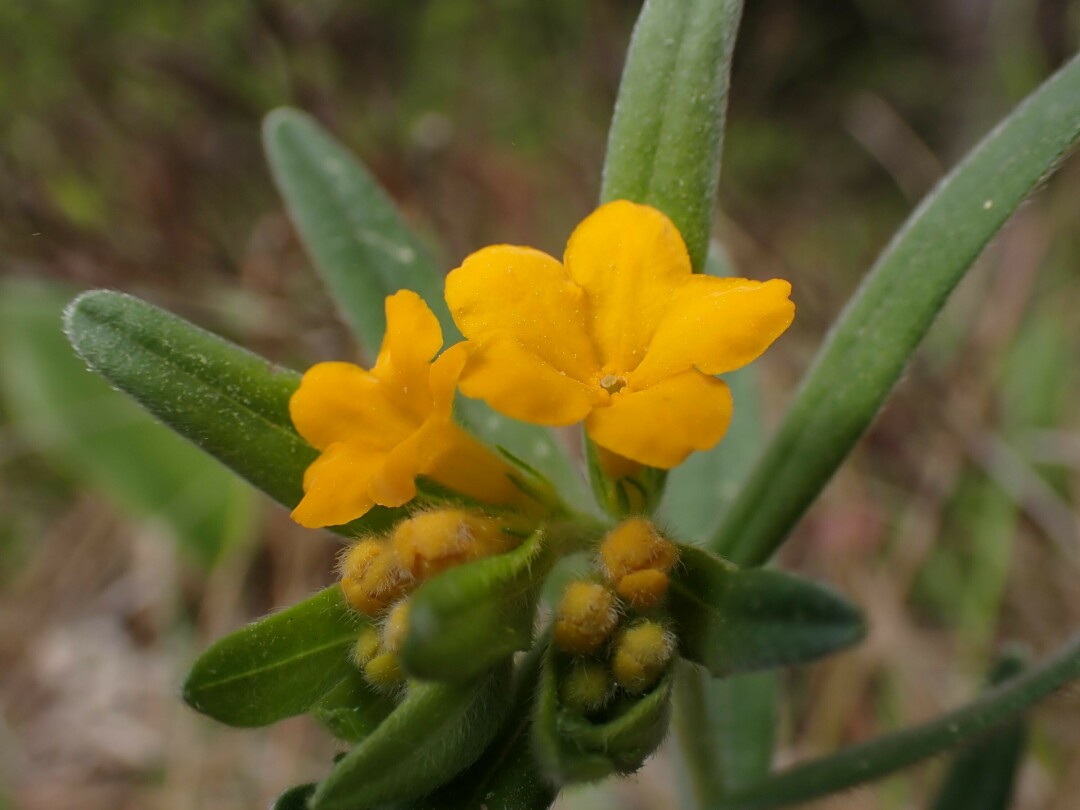Flowers from stone to sand

Hoary puccoon plants are covered with downy hairs that give the leaves a silvery look. Photos by Emily Stone.
Scraggly jack pines flew past the windows while I took one hand off the steering wheel to scratch a mosquito bite.
My wildflower hike to the North Country Trail Hardwoods State Natural Area a few days prior had been absolutely lovely, but there had been bugs. Now I was heading out for another adventure – checking on the pink blossoms of bird’s eye primrose I’d spotted on Artist’s Point in Grand Marais, Minnesota, earlier in the spring.
In this section of my drive, north of Barnes, Wisconsin, I knew I was miles from any gas station. So, when the need for a pit stop arose, I simply turned off on a forest road. Soft, sandy anthills shifted under my feet, and the lovely smell of warm pine needles rose up from beneath the trees. A little serviceberry shrub with floppy white flowers glowed on the edge of the dim shade.
Then some brighter white flowers caught my eye. With five symmetrical petals joined in a rosy center and a cluster of anthers bursting from the heart like fireworks of golden pollen, I knew this was a member of the Rose Family, just like the serviceberry.
A closer look at how the flowers attached to the stem in small groups, the glossy leaves, and knee-high stature told me that this was sand cherry, Prunus pumila.
As their name implies, sand cherry prefers sandy, well-drained soil. They spread by horizontal underground stems called rhizomes, which help to hold loose soil in place.
Although the plants themselves are much smaller than other types of cherries, the shiny black fruits of sand cherry are bigger! An ant crawled over one blossom while I snapped some photos. They are just one of many species of insects who visit this plant, including moth and butterfly adults and larvae, beneficial flies and native bees. Forty species of birds, plus foxes, coyotes, skunks, mice and humans also eat the cherries.
As I bounced from one cherry stem to another to find the best light for photos, some purple on the roadside caught my attention, too. Soon I was looking at a clump of dusky blue violets with unusually large flowers. A tight bundle of orange stamens in the center of each blossom – with a runway of linear nectar guides pointing right to them – perfectly complimented the blue.
It was the leaves at the base of the flowers that gave them away. Instead of the normal broadly heart-shaped leaves, I found leaves divided into three graceful, narrow lobes, not unlike the toes on a bird’s foot.
This, of course, was birdfoot violet. They need sandy soil to keep their feet dry and avoid rot. And they are programmed to bloom when the days reach a certain length in spring. Occasionally you’ll find one blooming in the fall, too, as day length revisits the same milestone on our way to winter.
Once the violet flowers are pollinated by bees or butterflies, the seeds that form each come with a little packet of fatty goodness attached to the outside. Ants love these elaiosomes and carry the seed back to their nest to nibble them off, then toss the clean seed in their compost pile. Elaiosomes are essentially a bribe for the ants’ seed dispersal services.
A splash of apricot orange among the short grasses next caught my eye. Each flower in the cluster was composed of five petals that met in the center and formed a little tube.
Upon close examination, the round, yellow buds and skinny, blunt leaves were covered in downy hairs, giving them a silvery, “hoary” look. The hairs of hoary puccoon can provide both warmth in early spring, and shade from a glaring Sun – a good adaptation for this open, dry habitat.
Puccoon is the misspelling of a Powhatan or Algonquian word that means a plant that can be used to make dye. The long taproot, which likes to wiggle down into sandy or silty soil, produces a purplish juice.
As I climbed back into my car with a camera full of more lovely wildflower photos, I smiled at my good luck.
Here in Wisconsin and Minnesota, we have quite a variety of habitats and soil types in a relatively small area. I can explore rich soils and maple forests filled with trilliums, wild oats, and large-flowered bellwort one day, then delight in the bedrock home of bird’s eye primrose (and a not-yet-booming mystery plant) the next. And now here I was enjoying prairie flowers in a barrens!
What do we have to thank for these riches? Why the glaciers, of course! The trillium’s rich soil developed from glacial till. The primrose enjoys bedrock scraped clean and exposed by the powerful ice.
They also take advantage of climate control provided by the cold waters of Lake Superior – whose basin was deepened by the glaciers and filled with melt. The drought tolerant cherries, violets, and puccoons benefit from a huge pile of glacial outwash debris, in a landscape called the Northwest Sands.
Even though we’ve taken down our geology exhibit at the museum, I won’t stop noticing how geology underlies everything!
If you want a refresher on that topic, you can find a link to a PDF with all the text and diagrams from our geology exhibit at cablemuseum.org/exhibit.
Here in the Northwoods, geology is the foundation for flowers as well as fun!
Emily M. Stone is Naturalist/Educator at the Cable Natural History Museum. Her award-winning second book, Natural Connections: Dreaming of an Elfin Skimmer, is available to purchase at cablemuseum.org/books and at your local independent bookstore, too. For more than 50 years, the Cable Natural History Museum has served to connect you to the Northwoods.
